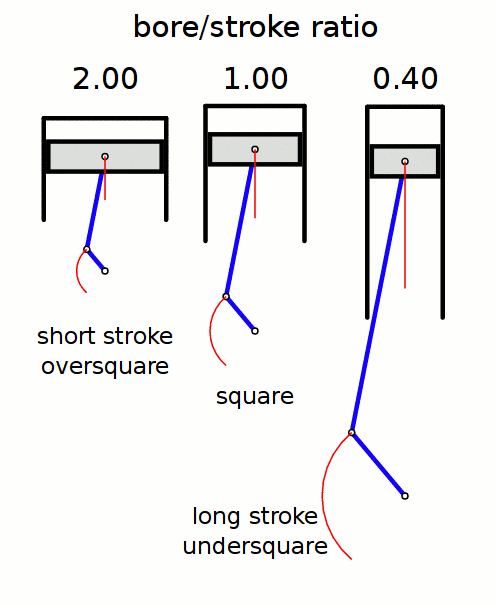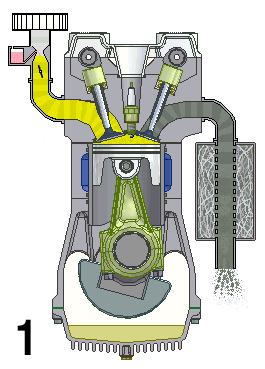|
Chrysler K Engine
The 2.2 and 2.5, also known as the Trenton Engine due to their manufacturing location, are a family of overhead cam inline-4 engines developed by Chrysler Corporation originally for the Chrysler K- and L-platforms cars and subsequently used in many other Chrysler vehicles. After its launch in 1981, it became the basis for all Chrysler-developed 4-cylinder engines until the Chrysler 1.8, 2.0 & 2.4 engine family was released in 1994. It was the first Chrysler-engineered four-cylinder engine since the Chrysler flathead four-cylinder was discontinued in 1933. The engine block and valvetrain were not derived from the overhead valve Chrysler LA series V8 that was in production then. 2.2 The first version of this engine family was a normally aspirated unit. Developed under the leadership of Chief Engineer – Engine Design and Development Willem Weertman and head of performance tuning Charles "Pete" Hagenbuch, who had worked on most of Chrysler's V-8 engines and the Chrysler ... [...More Info...] [...Related Items...] OR: [Wikipedia] [Google] [Baidu] |
Fuel Injection
Fuel injection is the introduction of fuel in an internal combustion engine, most commonly automotive engines, by the means of a fuel injector. This article focuses on fuel injection in reciprocating piston and Wankel rotary engines. All compression-ignition engines (e.g. diesel engines), and many spark-ignition engines (i.e. petrol (gasoline) engines, such as Otto or Wankel), use fuel injection of one kind or another. Mass-produced diesel engines for passenger cars (such as the Mercedes-Benz OM 138) became available in the late 1930s and early 1940s, being the first fuel-injected engines for passenger car use. In passenger car petrol engines, fuel injection was introduced in the early 1950s and gradually gained prevalence until it had largely replaced carburetors by the early 1990s. The primary difference between carburetion and fuel injection is that fuel injection atomizes the fuel through a small nozzle under high pressure, while carburetion relies on suction crea ... [...More Info...] [...Related Items...] OR: [Wikipedia] [Google] [Baidu] |
Chrysler Corporation
FCA US, LLC, doing business as Stellantis North America and known historically as Chrysler ( ), is one of the " Big Three" automobile manufacturers in the United States, headquartered in Auburn Hills, Michigan. It is the American subsidiary of the multinational automotive company Stellantis. Stellantis North America sells vehicles worldwide under the Chrysler, Dodge, Jeep, and Ram Trucks nameplates. It also includes Mopar, its automotive parts and accessories division, and SRT, its performance automobile division. The division also distributes Alfa Romeo, Fiat, and Maserati vehicles in North America. The original Chrysler Corporation was founded in 1925 by Walter Chrysler from the remains of the Maxwell Motor Company. In 1998, it merged with Daimler-Benz, which renamed itself DaimlerChrysler but in 2007 sold off its Chrysler stake. The company operated as Chrysler LLC through 2009, then as Chrysler Group LLC. In 2014, it was acquired by Fiat S.p.A.; it subsequently operated ... [...More Info...] [...Related Items...] OR: [Wikipedia] [Google] [Baidu] |
Interference Engine
An interference engine is a type of 4-stroke internal combustion piston engine in which one or more valves in the fully open position extends into any area through which the piston may travel. By contrast, in a non-interference engine, the piston does not travel into any area into which the valves open. Interference engines rely on timing gears, chains, or belts to prevent the piston from striking the valves by ensuring that the valves are closed when the piston is near top dead center. Interference engines are prevalent among modern production automobiles and many other four-stroke engine applications; the main advantage is that it allows engine designers to maximize the engine's compression ratio. However, such engines risk major internal damage if a piston strikes a valve due to failure of camshaft drive belts, drive chains, or drive gears. Timing gear failure In interference engine designs, replacing a timing belt in regular intervals (manufacturers recommend intervals rang ... [...More Info...] [...Related Items...] OR: [Wikipedia] [Google] [Baidu] |
Undersquare
Stroke ratio, today universally defined as bore/stroke ratio, is a term to describe the ratio between cylinder bore diameter and piston stroke length in a reciprocating piston engine. This can be used for either an internal combustion engine, where the fuel is burned within the cylinders of the engine, or external combustion engine, such as a steam engine, where the combustion of the fuel takes place ''outside'' the working cylinders of the engine. Conventions The contemporary convention for describing the ''stroke ratio'' of a piston engine‘s cylinders is its ''bore/stroke'' ratio. ''Stroke/bore'' ratio is an obsolete expression dating to the early era of reciprocating engine development. Bore/stroke ratio The diameter of the cylinder bore is divided by the length of the piston stroke to give the ratio. Square, oversquare and undersquare engines The following terms describe the naming conventions for the configurations of the various bore/stroke ratio: Square A square ... [...More Info...] [...Related Items...] OR: [Wikipedia] [Google] [Baidu] |
Plymouth Reliant
The Plymouth Reliant and Dodge Aries are mid size cars introduced for model year 1981 as the first " K-cars" manufactured and marketed by the Chrysler Corporation. The Reliant and Aries were the smallest cars to have the traditional 6 passenger 2 bench seat with column shifter seating arrangement favored by customers in the United States (Chrysler marketed the car as being able to seat "six Americans"), similar to larger rear-wheel drive cars such as the Dodge Dart and other front-wheel drive cars such as the Chevrolet Celebrity. The Reliant was powered by a then-new 2.2 L I4 SOHC engine, with a Mitsubishi "Silent Shaft" 2.6 L as an option (this engine also featured hemispherical combustion chambers, and all 1981 models equipped with it featured "HEMI" badges on the front fenders). The Reliant was available as a 2-door coupe, 4-door sedan, or as a 4-door station wagon, in three different trim lines: base, Custom and SE ("Special Edition"). Station wagons came only in Cu ... [...More Info...] [...Related Items...] OR: [Wikipedia] [Google] [Baidu] |
Plymouth Horizon
The horizon is the apparent curve that separates the surface of a celestial body from its sky when viewed from the perspective of an observer on or near the surface of the relevant body. This curve divides all viewing directions based on whether it intersects the relevant body's surface or not. The ''true horizon'' is a theoretical line, which can only be observed to any degree of accuracy when it lies along a relatively smooth surface such as that of Earth's oceans. At many locations, this line is obscured by terrain, and on Earth it can also be obscured by life forms such as trees and/or human constructs such as buildings. The resulting intersection of such obstructions with the sky is called the ''visible horizon''. On Earth, when looking at a sea from a shore, the part of the sea closest to the horizon is called the offing. Pronounced, "Hor-I-zon". The true horizon surrounds the observer and it is typically assumed to be a circle, drawn on the surface of a perfectly spher ... [...More Info...] [...Related Items...] OR: [Wikipedia] [Google] [Baidu] |
Dodge Omni
The Dodge Omni is a subcompact, subcompact car that was manufactured by Chrysler, Chrysler Corporation from the 1978 to 1990 model years. Marketed alongside the Plymouth Horizon, the Omni was the first front-wheel drive Chrysler vehicle; the pair were the first front-wheel-drive Economy car#1970s, economy cars assembled in the United States. The Omni and Horizon were developed from the Chrysler Horizon designed by Chrysler Europe, undergoing extensive modifications to meet U.S. standards. The design was heavily inspired by the Volkswagen Golf Mk1#Volkswagen Rabbit/Golf (U.S.A./Canada), Volkswagen Rabbit five-door hatchback (with early versions using Volkswagen-produced engines). Known as the Chrysler L platform, the chassis architecture used by the Omni/Horizon was also adopted by 3-door coupes and 2-door coupe-utility pickups. Through its twelve-year production, approximately 2.5 million units of the combined model lines were sold, with the Plymouth Horizon outselling ... [...More Info...] [...Related Items...] OR: [Wikipedia] [Google] [Baidu] |
Dodge Aries
The Plymouth Reliant and Dodge Aries are Mid-size car, mid size cars introduced for model year 1981 as the first "Chrysler K platform, K-cars" manufactured and marketed by the Chrysler, Chrysler Corporation. The Reliant and Aries were the smallest cars to have the traditional 6 passenger 2 bench seat with column shifter seating arrangement favored by customers in the United States (Chrysler marketed the car as being able to seat "six Americans"), similar to larger rear-wheel drive cars such as the Dodge Dart and other front-wheel drive cars such as the Chevrolet Celebrity. The Reliant was powered by a then-new Chrysler K engine, 2.2 L I4 overhead camshaft#Single overhead camshaft, SOHC engine, with a Mitsubishi Motors, Mitsubishi "Silent Shaft" 2.6 L as an option (this engine also featured hemispherical combustion chambers, and all 1981 models equipped with it featured "HEMI" badges on the front fenders). The Reliant was available as a 2-door coupe, 4-door sedan (car), sed ... [...More Info...] [...Related Items...] OR: [Wikipedia] [Google] [Baidu] |
Chrysler Slant-6 Engine
The Chrysler Slant-Six is the popular name for an overhead valve inline-6 engine produced by Chrysler Motors between 1959 and 2000. Featuring a reverse-flow cylinder head and cylinder bank inclined at a 30-degree angle from vertical, it was introduced in and displacements for the 1960 model year. It was a clean-sheet design known within Chrysler as the G-engine, built as a direct replacement for the flathead Chrysler straight six that the company started business with in 1925. The design proved very successful, being utilized in cars, trucks, boats, and agricultural, and industrial applications. Design The Chrysler Slant Six engine was a clean-sheet design, led by Willem Weertman, later Chrysler's chief engine designer. Its characteristic 30° inclined cylinder block gave it a lower height, copying the same cant Mercedes-Benz had introduced in 1952 in its M186-engined 300SL sports car. This enabled Chrysler stylists to lower hood lines, and also made room for the ... [...More Info...] [...Related Items...] OR: [Wikipedia] [Google] [Baidu] |
Willem Weertman
Willem Weertman is an American engineer known for his work as an engineer at Chrysler Corporation, where he was actively involved in the creation of many of the company's most famous engines, including the Slant Six, 2.2 four, and LA V8 (318, 360). He graduated from Yale University with a bachelor of engineering degree in 1947 before joining the Chrysler Institute of Engineering. In 1949, he started work at the Plymouth Assembly Plant before spending 1950–1952 with the Navy in the Korean War. In 1954, Weertman became the first resident engineer for the Plymouth Mound Road V8 engine plant, which started producing A-engines in 1955. In December 1955, Weertman was promoted up to the Engine Design Department of Chrysler's Central Engineering department and assigned a title of Manager - Engine Design. In this capacity he worked on the Chrysler B engine and Slant Six, which would become known for its durability and at the time was considered to have high performance for its size. ... [...More Info...] [...Related Items...] OR: [Wikipedia] [Google] [Baidu] |
Normally Aspirated
A naturally aspirated engine, also known as a normally aspirated engine, and abbreviated to N/A or NA, is an internal combustion engine in which air intake depends solely on atmospheric pressure and does not have forced induction through a turbocharger or a supercharger. Description In a naturally aspirated engine, air for combustion (Diesel cycle in a diesel engine or specific types of Otto cycle in petrol engines, namely petrol direct injection) or an air/fuel mixture (traditional Otto cycle petrol engines), is drawn into the engine's cylinders by atmospheric pressure acting against a partial vacuum that occurs as the piston travels downwards toward bottom dead centre during the intake stroke. Owing to innate restriction in the engine's inlet tract, which includes the intake manifold, a small pressure drop occurs as air is drawn in, resulting in a volumetric efficiency of less than 100 percent—and a less than complete air charge in the cylinder. The density of the air ... [...More Info...] [...Related Items...] OR: [Wikipedia] [Google] [Baidu] |
Chrysler LA Engine
The LA engine is a family of overhead valve engine, overhead-valve small-block 90° V engine, V-configured gasoline engines built by Chrysler Corporation between 1964 and 2003. Primarily V8s, the line includes a single V6 and V10, both derivations of its Magnum series introduced in 1992. A replacement of the Chrysler A engine, they were factory-installed in passenger vehicles, trucks and vans, commercial vehicles, marine and industrial applications. Their combustion chambers are wedge-shaped, rather than polyspheric, as in the A engine, or hemispherical combustion chamber, hemispheric in the Chrysler Chrysler Hemi engine, Hemi. LA engines have the same bore spacing as the A engines. LA engines were made at Chrysler's Mound Road Engine plant in Detroit, Michigan, as well as plants in Canada and Mexico. The "LA" stands for "Light A," as the 1956–1967 "Chrysler A engine, A" engine it was closely based on and shares many parts with was nearly 50 pounds heavier. The "LA" and "A" pro ... [...More Info...] [...Related Items...] OR: [Wikipedia] [Google] [Baidu] |






